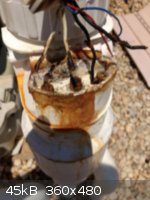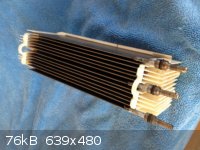mazda1949
Harmless

Posts: 2
Registered: 11-6-2013
Member Is Offline
Mood: No Mood
|
|
Broken wires on a Salt Cell
Hi folks I hope Im not posting in the wrong place. Anyway I have an Aqua Rite salt cell that the wires corroded on and broke where the cable exits
the salt cell going to the control box. The wires were coated and sealed with hard black silicone at the point where they broke. I scraped all the
silicone if that is what it really is away from the 3 studs exiting the cell. Im sure the 3 studs are attached to anodes and cathodes. I am confused
about it having 3 post to hook the wires back to. One of the studs with the attaching nuts has to be positive or negitive or cathode or anode. How can
this cell have an odd post unless it has something to do with the cell having reverse polarity capabilitys. Also the 3 post that are welded to the 3
plates inside the cell dont have any other connections to each other. It has 5 plates on each side of the middle anode Im going to call it. None of
these plates that are stacked between the middle anode and the outer 2 cathodes are attached to anything. They are just sitting there. When this
machine reverses polarity for the cleaning process , Is it still using all the plates to generate or just half? I guess what my real question here is,
How am I supposed to wire this thing back to make it work again? It has 2 white wires and 2 black wires that were attached previously but I dont know
in which configuration because when I scraped all that black stuff away it took all the color and insulation off what was left of the wires. The only
other wires that are present are one blue and one red wire which I know go to the temp sensor. I ohmed the 2 black wires and the 2 white wires back to
the plug in on the control board and found that the white wires and the black wires all go back to only 2 strips on the control board which are the
power for the salt cell.
Could someone here tell me exactly how I need to wire this thing back up. Here is my wild guess Both white wires on the middle pole and the 2
black wires on each outside poles. And if this is the way it wires can someone explain how the cell works in this configuration. Does it use all of
the salt cell plates at once or does it only use half at a time when the polarization changes. I really cant see this happening because both white and
black wires are powering all the time. Also explain how the plates that are just sitting there, how can they do anything without being attached. I
know the salt in the water makes it conductive. Is this how they attach.
I'll have to admit I have just been studying how a salt cell works just in the last few days. This stuff is real real interresting to me. Also Im
64 yrs old and cant seem to learn quiet as fast as I used to. I am a 45 yr owner of an auto repair shop and have to work with electrical stuff quiet a
bit so I think I can pick this stuff up if you all can help me a little bit. I would like to try my luck someday at building my own generator. I hope
I'll be able to fix the one I have now because my swimming pool water is turning green.
Thanks
|
|
|
chemcam
Hazard to Others
  
Posts: 423
Registered: 18-2-2013
Location: Atlantis
Member Is Offline
Mood: I will be gone until mid-september, on a work contract.
|
|
You are right the plates don't need to physically touch because the salt water is conductive. When current flows from the electrolytic plates,
through the salt water, the chloride ions become free chlorine which dissolves in the water. The sodium probably ends up as NaOH. Do you use something
to lower the pH as well ?
I have built a salt cell before, is there any way you can post pictures? I would imagine you already looked for a wiring diagram from the manufacturer
website. I can probably help you, but I need pictures.
Edit: The way you proposed, two in the middle and one on each side sounds like a good configuration but still pics would help.
[Edited on 6-12-2013 by chemcam]
|
|
|
mazda1949
Harmless

Posts: 2
Registered: 11-6-2013
Member Is Offline
Mood: No Mood
|
|
pic for you
Hope you can see what you need on this pic
 
|
|
|
Xenoid
National Hazard
   
Posts: 775
Registered: 14-6-2007
Location: Springs Junction, New Zealand
Member Is Offline
Mood: Comfortably Numb
|
|
Hi Mazda,
Yes, connect the two white wires to the central electrode and a black wire to each outside electrode as you suggest!
The reason the 5 electrode plates on each side are not connected is because they are what are called "bipolar electrodes" they develop an opposite
charge on each face. This has the advantage of simplifying internal connections, and thus lowering contact resistances. They work as though they are a
number of simple cells working in series. This means higher voltages are required but at a lower current. This arrangement is used commonly in pool
chlorinator cells (salt cells) and in various large industrial setups.
All electrodes are thus being used all the time.
Chlorinator cells do not last forever, do the titanium plates still have a good coating of black MMO (mixed metal oxide).
There are a few other discussions, descriptions and images on sciencemadness here:
(You may need to scroll up or down)
http://www.sciencemadness.org/talk/viewthread.php?tid=16144#...
http://www.sciencemadness.org/talk/viewthread.php?tid=9783&a...
http://www.sciencemadness.org/talk/viewthread.php?tid=5050&a...
http://www.sciencemadness.org/talk/viewthread.php?tid=9572&a...
http://www.sciencemadness.org/talk/viewthread.php?tid=5050&a...
(this last image is similar to your unit with solid bipolar electrodes - but also has internal connections)
Hope this is helpful - Xenoid
|
|
|